

Compact Muon Solenoid
LHC, CERN
| CMS-PAS-EXO-17-001 | ||
| Search for light vector resonances decaying to a quark pair produced in association with a jet in proton-proton collisions at $\sqrt{s}= $ 13 TeV | ||
| CMS Collaboration | ||
| May 2017 | ||
| Abstract: A search for narrow vector resonances decaying to a quark-antiquark pair is presented. The search is based on events collected in $\sqrt{s}= $ 13 TeV proton-proton collisions with the CMS detector at the LHC. The data sample, collected in 2016, corresponds to an integrated luminosity of 35.9 fb$^{-1}$. The hypothetical resonance is produced with sufficiently high transverse momentum that the decay products of the resonance are merged into a single jet. The resulting experimental signature is a single massive jet with two-prong substructure produced in association with a jet from initial-state radiation. Signal is identified as an enhancement over background processes in the distribution of the invariant mass of the jet. No evidence for such resonance is observed within the targeted mass range from 50-300 GeV. Upper limits at a 95% confidence level are set on the production cross-section of leptophobic vector resonances. Results are presented in a mass-coupling phase space and are the most sensitive to date, extending previous limits below 100 GeV. The limits also constrain simplified models of dark matter, with a leptophobic mediator interacting between quarks and dark matter particles through a vector or axial-vector current. | ||
|
Links:
CDS record (PDF) ;
inSPIRE record ;
CADI line (restricted) ;
These preliminary results are superseded in this paper, JHEP 01 (2018) 097. The superseded preliminary plots can be found here. |
||
| Figures & Tables | Summary | Additional Figures | References | CMS Publications |
|---|
| Figures | |
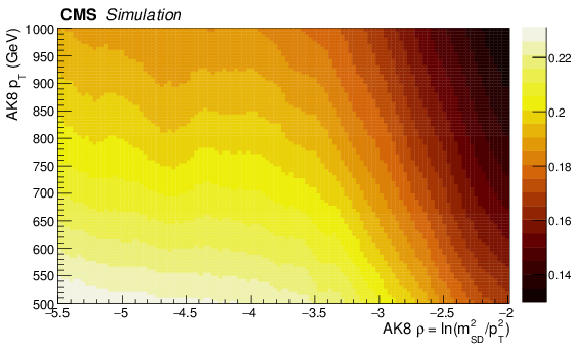
png pdf |
Figure 1:
$N_2^{1,\text {DDT}}$ transformation map built using a k-Nearest neighbor (kNN) approach and shown as a function of the jet $\rho $ and ${p_{\mathrm {T}}} $. The map corresponds to the 5% quantile of the $N_2^{1}$ distribution in simulated QCD multijet events. The $N_2^{1}$ distribution is mostly insensitive to the jet $\rho $ and ${p_{\mathrm {T}}}$ in the kinematic phase space considered for this analysis ($-5.5 < \rho < 2$) and further decorrelated yielding the $N_2^{1,\text {DDT}}$ variable. |
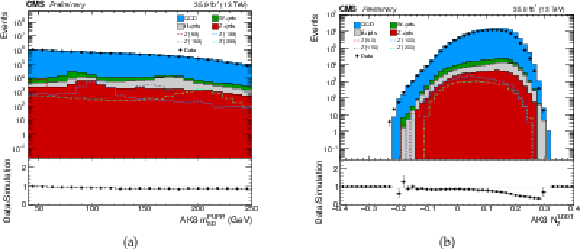
png pdf |
Figure 2:
Data to simulation comparison of the (a) leading ${p_{\mathrm {T}}}$ jet soft drop mass and (b) $N_2^{1,\text {DDT}}$ variables, after kinematic selections on the leading ${p_{\mathrm {T}}}$ jet. Dashed lines illustrate the signal contribution for different Z' masses. The multijet processes (QCD) dominate the background component, with subdominant contributions from inclusive SM W, Z, and ${\mathrm{ t } \mathrm{ \bar{t} } }$ processes. Residual differences in data and simulation demonstrate the need for a data-driven background estimation method. |
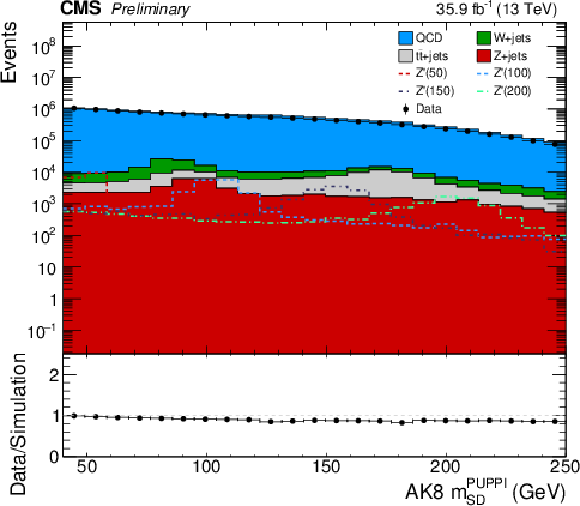
png pdf |
Figure 2-a:
Data to simulation comparison of the leading ${p_{\mathrm {T}}}$ jet soft drop mass. Dashed lines illustrate the signal contribution for different Z' masses. The multijet processes (QCD) dominate the background component, with subdominant contributions from inclusive SM W, Z, and ${\mathrm{ t } \mathrm{ \bar{t} } }$ processes. |

png pdf |
Figure 2-b:
Data to simulation comparison of the $N_2^{1,\text {DDT}}$ variables, after kinematic selections on the leading ${p_{\mathrm {T}}}$ jet. Dashed lines illustrate the signal contribution for different Z' masses. The multijet processes (QCD) dominate the background component, with subdominant contributions from inclusive SM W, Z, and ${\mathrm{ t } \mathrm{ \bar{t} } }$ processes. |
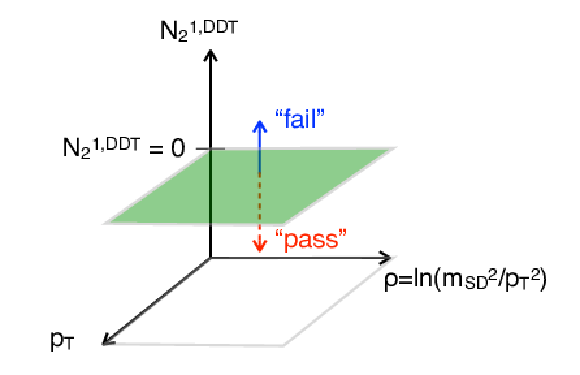
png pdf |
Figure 3:
A schematic of the background estimation method. The pass-to-fail ratio, translating from failing to passing regions after applying a $N_2^\text {1,DDT}$ selection, is extracted by performing a two-dimensional fit in ($ \rho , {p_{\mathrm {T}}} $) space. |
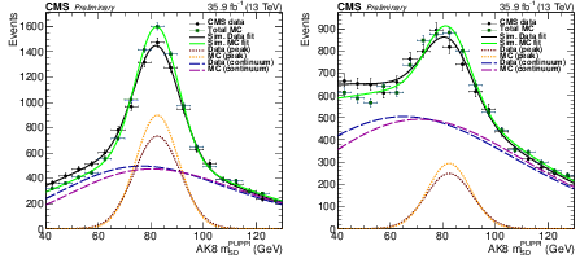
png pdf |
Figure 4:
Soft-drop jet mass distribution that pass (left) and fail (right) the $N_{2}^\text {1,DDT}$ selection in the semileptonic ${\mathrm{ t } \mathrm{ \bar{t} } }$ sample. Results of fits to data and simulation are shown. |
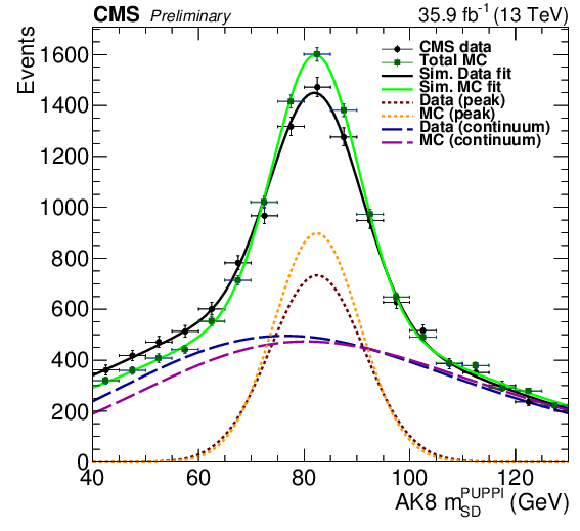
png pdf |
Figure 4-a:
Soft-drop jet mass distribution that pass the $N_{2}^\text {1,DDT}$ selection in the semileptonic ${\mathrm{ t } \mathrm{ \bar{t} } }$ sample. Results of fits to data and simulation are shown. |
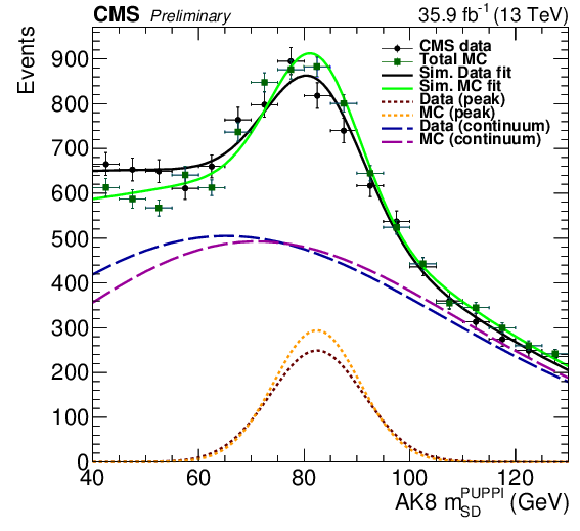
png pdf |
Figure 4-b:
Soft-drop jet mass distribution that fail the $N_{2}^\text {1,DDT}$ selection in the semileptonic ${\mathrm{ t } \mathrm{ \bar{t} } }$ sample. Results of fits to data and simulation are shown. |

png pdf |
Figure 5:
Soft drop jet mass distribution for the different ${p_{\mathrm {T}}}$ categories of the fit from 500-1000 GeV. Data are shown as the black points. The QCD background prediction, including uncertainties, is shown in the gray boxes. Contributions from the W, Z, and a hypothetical Z' signal at a mass of 135 GeV are indicated as well. In the bottom panel, the ratio of the data to the background prediction, including uncertainties, is shown. The scale on the x-axis differs for each ${p_{\mathrm {T}}}$ category due to the kinematic selection on $\rho $. |
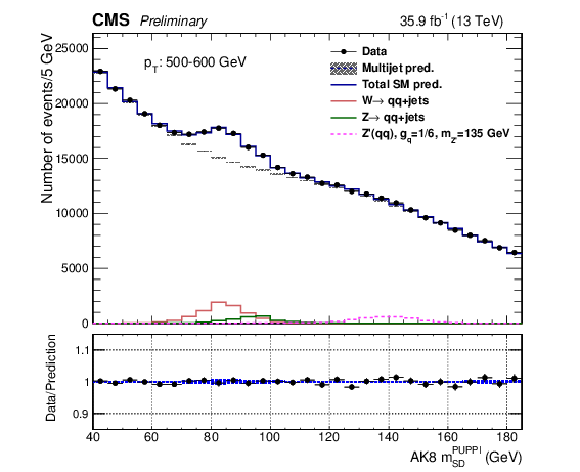
png pdf |
Figure 5-a:
Soft drop jet mass distribution for the 500-600 GeV ${p_{\mathrm {T}}}$ fit category. Data are shown as the black points. The QCD background prediction, including uncertainties, is shown in the gray boxes. Contributions from the W, Z, and a hypothetical Z' signal at a mass of 135 GeV are indicated as well. In the bottom panel, the ratio of the data to the background prediction, including uncertainties, is shown. |
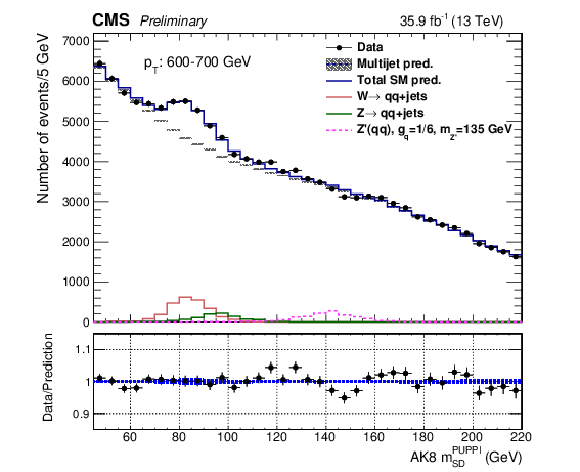
png pdf |
Figure 5-b:
Soft drop jet mass distribution for the 600-700 GeV ${p_{\mathrm {T}}}$ fit category. Data are shown as the black points. The QCD background prediction, including uncertainties, is shown in the gray boxes. Contributions from the W, Z, and a hypothetical Z' signal at a mass of 135 GeV are indicated as well. In the bottom panel, the ratio of the data to the background prediction, including uncertainties, is shown. |
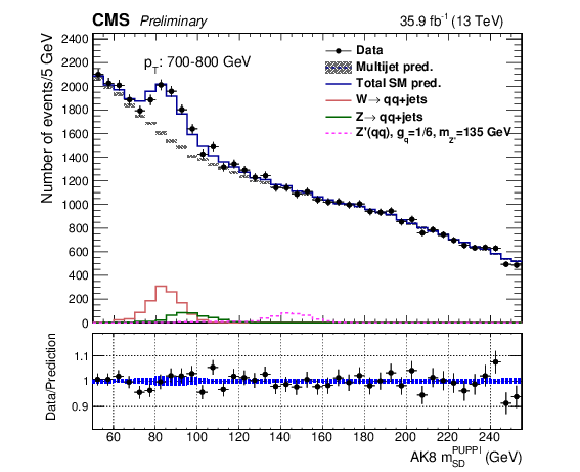
png pdf |
Figure 5-c:
Soft drop jet mass distribution for the 700-800 GeV ${p_{\mathrm {T}}}$ fit category. Data are shown as the black points. The QCD background prediction, including uncertainties, is shown in the gray boxes. Contributions from the W, Z, and a hypothetical Z' signal at a mass of 135 GeV are indicated as well. In the bottom panel, the ratio of the data to the background prediction, including uncertainties, is shown. |
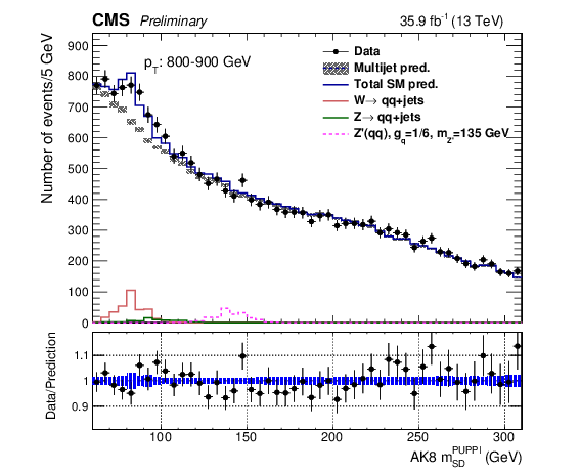
png pdf |
Figure 5-d:
Soft drop jet mass distribution for the 800-900 GeV ${p_{\mathrm {T}}}$ fit category. Data are shown as the black points. The QCD background prediction, including uncertainties, is shown in the gray boxes. Contributions from the W, Z, and a hypothetical Z' signal at a mass of 135 GeV are indicated as well. In the bottom panel, the ratio of the data to the background prediction, including uncertainties, is shown. |
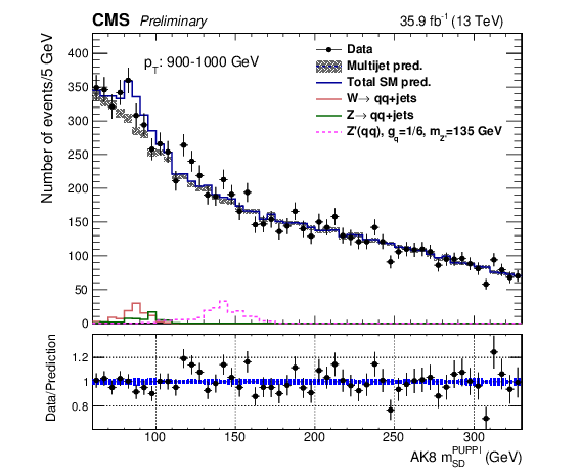
png pdf |
Figure 5-e:
Soft drop jet mass distribution for the 900-1000 GeV ${p_{\mathrm {T}}}$ fit category. Data are shown as the black points. The QCD background prediction, including uncertainties, is shown in the gray boxes. Contributions from the W, Z, and a hypothetical Z' signal at a mass of 135 GeV are indicated as well. In the bottom panel, the ratio of the data to the background prediction, including uncertainties, is shown. |
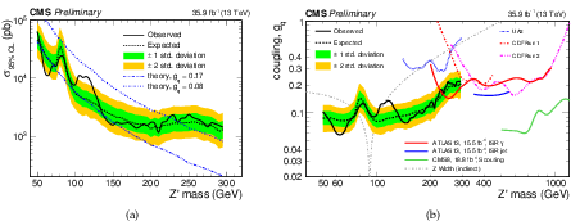
png pdf |
Figure 6:
(a) 95% CL upper limits on the Z' production cross section compared to the theoretical cross section and (b) translation of the upper limits to limits on $g_q$ as a function of the Z' mass. Limits from other relevant searches are also shown. An indirect constraint on a potential Z' signal from the SM Z boson width [68] is also shown. |
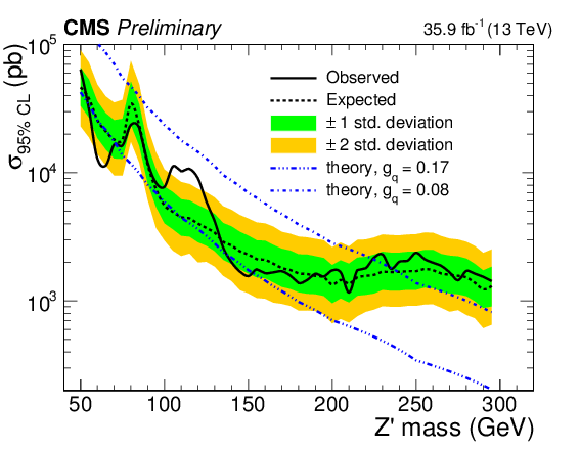
png pdf |
Figure 6-a:
95% CL upper limits on the Z' production cross section compared to the theoretical cross section. |
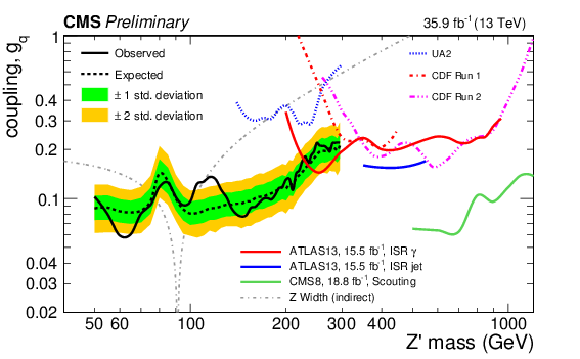
png pdf |
Figure 6-b:
Translation of the upper limits to limits on $g_q$ as a function of the Z' mass. Limits from other relevant searches are also shown. An indirect constraint on a potential Z' signal from the SM Z boson width [68] is also shown. |
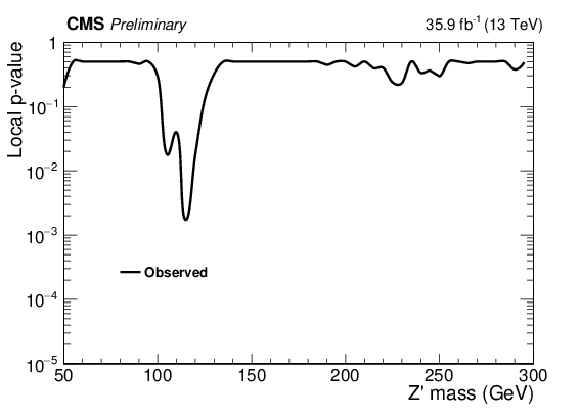
png pdf |
Figure 7:
The p-value as a function of Z' mass. The maximum local p-value, at 115 GeV , is $1.72\times 10^{-3}$ and the global p-value corresponds to 0.0138. |

png pdf |
Figure 8:
The 95% CL observed (red) excluded regions in the plane of dark matter mass ($m_{DM}$) vs. mediator mass ($m_{Z'}$), for vector mediators. The exclusion is computed with quark coupling choice $g_q = $ 0.25 and for a dark matter coupling $g_{DM} = $ 1. The excluded regions from the dijet resolved analysis using 2016 data [36] are shown in blue. |
| Tables | |
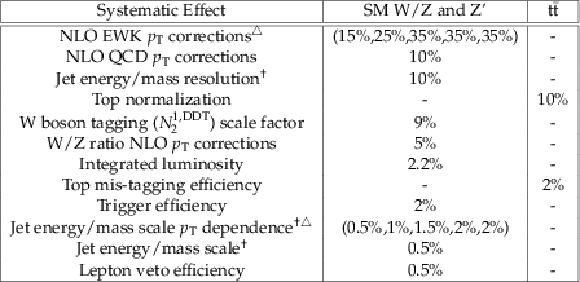
png pdf |
Table 1:
Summary of the systematic uncertainties for signal and subdominant background processes and their relative size. Symbol $^\dagger $ denotes a shape uncertainty on the peaking SM W/Z and Z' signal shape. Symbol $^\triangle $ denotes uncertainties decorrelated per ${p_{\mathrm {T}}}$ bin between 500-1000 GeV, for the SM W/Z and Z' processes. |
| Summary |
| In summary, we present a search for a light Z' boson decaying to a quark-antiquark pair and reconstructed as a single jet at $\sqrt{s} = $ 13 TeV using a data sample corresponding to an integrated luminosity of 35.9 fb$^{-1}$. Novel substructure techniques are employed to identify the Z' jets. The signal is then extracted on top of a falling QCD soft drop mass distribution (including contributions from W, Z, and top background processes) using an entirely data-driven QCD background prediction. We observe a modest excess near 115 GeV with the largest local significance of 2.9$\sigma$ and global significance of 2.2$\sigma$. We set 95% CL upper limits on the Z' coupling to quarks, $g_q$, as a function of the Z' mass. We present limits for the first time in the mass range from 50-100 GeV with the CMS detector. We exclude coupling values of $g_q > 0.25$ over the Z' mass range from 50 to 300 GeV with strong constraints below Z' masses of 200 GeV. |
| Additional Figures | |
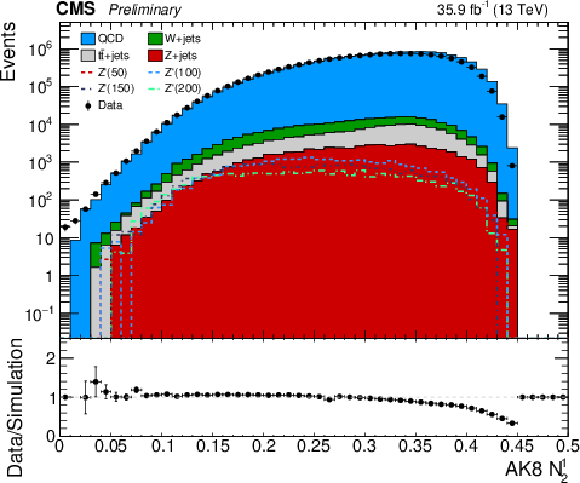
png pdf |
Additional Figure 1:
Data to simulation comparison of the $N_2^{1}$ observable of the leading ${p_{\mathrm {T}}}$ jet, after kinematic selections. Dashed lines illustrate the signal contribution for different Z' masses. The multijet processes (QCD) dominate the background component, with subdominant contributions from inclusive SM W,Z, and ${\mathrm{ t } {}\mathrm{ \bar{t} } }$ processes. Residual differences in data and simulation demonstrate the need for a data-driven background estimation method. |
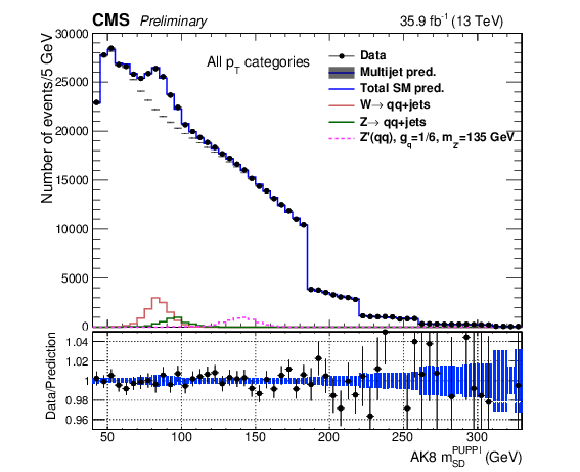
png pdf |
Additional Figure 2:
Soft drop jet mass distribution for all ${p_{\mathrm {T}}}$ categories of the fit from 500-1000 GeV. Data are shown as the black points. The QCD background prediction, including uncertainties, is shown in the gray boxes. Contributions from the W, Z, and a hypothetical Z$^{\prime }$ signal at a mass of 135 GeV are indicated as well. In the bottom panel, the ratio of the data to the background prediction, including uncertainties, is shown. Only events in the $\rho $ range $-5.5 < \rho < -2$ are considered. |
| References | ||||
| 1 | L. A. Anchordoqui et al. | Dijet signals for low mass strings at the LHC | PRL 101 (2008) 241803 | 0808.0497 |
| 2 | S. Cullen, M. Perelstein, and M. E. Peskin | TeV strings and collider probes of large extra dimensions | PRD 62 (2000) 055012 | hep-ph/0001166 |
| 3 | J. L. Hewett and T. G. Rizzo | Low-Energy Phenomenology of Superstring Inspired E(6) Models | PR 183 (1989) 193 | |
| 4 | U. Baur, I. Hinchliffe, and D. Zeppenfeld | Excited Quark Production at Hadron Colliders | Int. J. Mod. Phys. A 2 (1987) 1285 | |
| 5 | U. Baur, M. Spira, and P. Zerwas | Excited quark and lepton production at hadron colliders | PRD 42 (1990) 815--824 | |
| 6 | P. H. Frampton and S. L. Glashow | Chiral Color: An Alternative to the Standard Model | PLB 190 (1987) 157 | |
| 7 | R. S. Chivukula, A. Farzinnia, E. H. Simmons, and R. Foadi | Production of Massive Color-Octet Vector Bosons at Next-to-Leading Order | PRD 85 (2012) 054005 | 1111.7261 |
| 8 | E. H. Simmons | Coloron phenomenology | PRD 55 (1997) 1678--1683 | hep-ph/9608269 |
| 9 | T. Han, I. Lewis, and Z. Liu | Colored Resonant Signals at the LHC: Largest Rate and Simplest Topology | JHEP 1012 (2010) 085 | 1010.4309 |
| 10 | E. Eichten, I. Hinchliffe, K. D. Lane, and C. Quigg | Super Collider Physics | Rev. Mod. Phys. 56 (1984) 579--707 | |
| 11 | L. Randall and R. Sundrum | An Alternative to compactification | PRL 83 (1999) 4690--4693 | hep-th/9906064 |
| 12 | UA1 Collaboration | Two Jet Mass Distributions at the CERN Proton - Anti-Proton Collider | PLB 209 (1988) 127--134 | |
| 13 | UA2 Collaboration | A Measurement of two jet decays of the $ W $ and $ Z $ bosons at the CERN $ \bar{p} p $ collider | Z. Phys. C 49 (1991) 17--28 | |
| 14 | UA2 Collaboration | A Search for new intermediate vector mesons and excited quarks decaying to two jets at the CERN $ \bar{p} p $ collider | Nucl. Phys. B 400 (1993) 3--24 | |
| 15 | CDF Collaboration | The Two jet invariant mass distribution at $ \sqrt{s} = $ 1.8 TeV | PRD 41 (1990) 1722--1725 | |
| 16 | CDF Collaboration | Search for quark compositeness, axigluons and heavy particles using the dijet invariant mass spectrum observed in $ p\bar{p} $ collisions | PRL 71 (1993) 2542--2546 | |
| 17 | CDF Collaboration | Search for new particles decaying to dijets in $ p\bar{p} $ collisions at $ \sqrt{s} = $ 1.8 TeV | PRL 74 (1995) 3538--3543 | hep-ex/9501001 |
| 18 | CDF Collaboration | Search for new particles decaying to dijets at CDF | PRD 55 (1997) 5263--5268 | hep-ex/9702004 |
| 19 | CDF Collaboration | Search for new particles decaying into dijets in proton-antiproton collisions at $ \sqrt{s} = $ 1.96 TeV | PRD 79 (2009) 112002 | 0812.4036 |
| 20 | D0 Collaboration | Search for new particles in the two jet decay channel with the D0 detector | PRD 69 (2004) 111101 | hep-ex/0308033 |
| 21 | ATLAS Collaboration | Search for New Particles in Two-Jet Final States in 7 TeV Proton-Proton Collisions with the ATLAS Detector at the LHC | PRL 105 (2010) 161801 | 1008.2461 |
| 22 | ATLAS Collaboration | Search for New Physics in Dijet Mass and Angular Distributions in pp Collisions at $ \sqrt{s} = $ 7 TeV Measured with the ATLAS Detector | New J. Phys. 13 (2011) 053044 | 1103.3864 |
| 23 | ATLAS Collaboration | Search for New Physics in the Dijet Mass Distribution using 1 fb$ ^{-1} $ of $ pp $ Collision Data at $ \sqrt{s} = $ 7 TeV collected by the ATLAS Detector | PLB 708 (2012) 37--54 | 1108.6311 |
| 24 | ATLAS Collaboration | ATLAS search for new phenomena in dijet mass and angular distributions using $ pp $ collisions at $ \sqrt{s} = $ 7 TeV | JHEP 01 (2013) 029 | 1210.1718 |
| 25 | ATLAS Collaboration | Search for new phenomena in the dijet mass distribution using $ p-p $ collision data at $ \sqrt{s} = $ 8 TeV with the ATLAS detector | PRD 91 (2015), no. 5, 052007 | 1407.1376 |
| 26 | ATLAS Collaboration | Search for new phenomena in dijet mass and angular distributions from $ pp $ collisions at $ \sqrt{s}= $ 13 TeV with the ATLAS detector | PLB754 (2016) 302--322 | 1512.01530 |
| 27 | ATLAS Collaboration | Search for light dijet resonances with the ATLAS detector using a Trigger-Level Analysis in LHC pp collisions at $ \sqrt{s} = $ 13 TeV | Technical Report ATLAS-CONF-2016-030, CERN, Geneva, Jun | |
| 28 | ATLAS Collaboration | Search for new phenomena in dijet events using 37 fb$ ^{-1} $ of $ pp $ collision data collected at $ \sqrt{s}= $ 13 TeV with the ATLAS detector | 1703.09127 | |
| 29 | CMS Collaboration | Search for Dijet Resonances in 7 TeV pp Collisions at CMS | PRL 105 (2010) 211801 | CMS-EXO-10-010 1010.0203 |
| 30 | CMS Collaboration | Search for Resonances in the Dijet Mass Spectrum from 7 TeV pp Collisions at CMS | PLB 704 (2011) 123--142 | CMS-EXO-11-015 1107.4771 |
| 31 | CMS Collaboration | Search for narrow resonances and quantum black holes in inclusive and $ b $-tagged dijet mass spectra from $ pp $ collisions at $ \sqrt{s} = $ 7 TeV | JHEP 01 (2013) 013 | CMS-EXO-11-094 1210.2387 |
| 32 | CMS Collaboration | Search for narrow resonances using the dijet mass spectrum in pp collisions at $ \sqrt{s} $=8 TeV | PRD 87 (2013), no. 11, 114015 | CMS-EXO-12-016 1302.4794 |
| 33 | CMS Collaboration | Search for resonances and quantum black holes using dijet mass spectra in proton-proton collisions at $ \sqrt{s} = $ 8 TeV | PRD 91 (2015), no. 5, 052009 | CMS-EXO-12-059 1501.04198 |
| 34 | CMS Collaboration | Search for narrow resonances decaying to dijets in proton-proton collisions at $ \sqrt(s) = $ 13 TeV | PRL 116 (2016), no. 7, 071801 | CMS-EXO-15-001 1512.01224 |
| 35 | CMS Collaboration | Search for narrow resonances in dijet final states at sqrt(s)=8 TeV with the novel CMS technique of data scouting | CMS-EXO-14-005 1604.08907 |
|
| 36 | CMS Collaboration | Searches for dijet resonances in pp collisions at $ \sqrt{s}= $ 13 TeV using data collected in 2016. | CMS-PAS-EXO-16-056 | CMS-PAS-EXO-16-056 |
| 37 | ATLAS Collaboration | Search for new light resonances decaying to jet pairs and produced in association with a photon in proton-proton collisions at $ \sqrt{s} = $ 13 TeV with the ATLAS detector | Technical Report ATLAS-CONF-2016-029, CERN, Geneva, Jun | |
| 38 | CMS Collaboration | Search for light vector resonances decaying to quarks at 13 TeV | CMS-PAS-EXO-16-030 | CMS-PAS-EXO-16-030 |
| 39 | B. A. Dobrescu and F. Yu | Coupling-mass mapping of dijet peak searches | PRD 88 (2013), no. 3, 035021 | 1306.2629 |
| 40 | D. Abercrombie et al. | Dark Matter Benchmark Models for Early LHC Run-2 Searches: Report of the ATLAS/CMS Dark Matter Forum | 1507.00966 | |
| 41 | CMS Collaboration | The CMS experiment at the CERN LHC | JINST 3 (2008) S08004 | CMS-00-001 |
| 42 | D. Krohn, J. Thaler, and L.-T. Wang | Jet Trimming | JHEP 02 (2010) 084 | 0912.1342 |
| 43 | M. Cacciari, G. P. Salam, and G. Soyez | The anti-$ k_t $ jet clustering algorithm | JHEP 04 (2008) 063 | 0802.1189 |
| 44 | J. Alwall et al. | The automated computation of tree-level and next-to-leading order differential cross sections, and their matching to parton shower simulations | JHEP 07 (2014) 079 | 1405.0301 |
| 45 | J. Alwall et al. | Comparative study of various algorithms for the merging of parton showers and matrix elements in hadronic collisions | EPJC53 (2008) 473--500 | 0706.2569 |
| 46 | S. Frixione, P. Nason, and C. Oleari | Matching NLO QCD computations with parton shower simulations: the POWHEG method | JHEP 11 (2007) 070 | 0709.2092 |
| 47 | T. Sjostrand, S. Mrenna, and P. Skands | PYTHIA 6.4 physics and manual | JHEP 05 (2006) 026 | hep-ph/0603175 |
| 48 | T. Sjostrand, S. Mrenna, and P. Z. Skands | A Brief Introduction to PYTHIA 8.1 | CPC 178 (2008) 852--867 | 0710.3820 |
| 49 | GEANT4 Collaboration | GEANT4: A Simulation toolkit | NIMA506 (2003) 250--303 | |
| 50 | CMS Collaboration | Search for dark matter produced with an energetic jet or a hadronically decaying W or Z boson at $ \sqrt{s} = $ 13 TeV | CMS-EXO-16-037 1703.01651 |
|
| 51 | S. Kallweit et al. | NLO electroweak automation and precise predictions for W+multijet production at the LHC | JHEP 04 (2015) 012 | 1412.5157 |
| 52 | S. Kallweit et al. | NLO QCD+EW predictions for V + jets including off-shell vector-boson decays and multijet merging | JHEP 04 (2016) 021 | 1511.08692 |
| 53 | S. Kallweit et al. | NLO QCD+EW automation and precise predictions for V+multijet production | in Proceedings, 50th Rencontres de Moriond, QCD and high energy interactions, 2015 | 1505.05704 |
| 54 | M. Schönherr et al. | NLO QCD+EW for V+jets | PoS LHCP2016 (2016) 058 | 1609.01445 |
| 55 | CMS Collaboration | Particle--Flow Event Reconstruction in CMS and Performance for Jets, Taus, and $ E_{\mathrm{T}}^{\text{miss}} $ | ||
| 56 | CMS Collaboration | Commissioning of the Particle-flow Event Reconstruction with the first LHC collisions recorded in the CMS detector | CDS | |
| 57 | D. Bertolini, P. Harris, M. Low, and N. Tran | Pileup Per Particle Identification | JHEP 10 (2014) 059 | 1407.6013 |
| 58 | M. Dasgupta, A. Fregoso, S. Marzani, and G. P. Salam | Towards an understanding of jet substructure | JHEP 09 (2013) 029 | 1307.0007 |
| 59 | A. J. Larkoski, S. Marzani, G. Soyez, and J. Thaler | Soft Drop | JHEP 05 (2014) 146 | 1402.2657 |
| 60 | I. Moult, L. Necib, and J. Thaler | New Angles on Energy Correlation Functions | JHEP 12 (2016) 153 | 1609.07483 |
| 61 | J. Dolen et al. | Thinking outside the ROCs: Designing Decorrelated Taggers (DDT) for jet substructure | JHEP 05 (2016) 156 | 1603.00027 |
| 62 | S. Dudani | The distance-weighted k-nearest-neighbor rule | IEEE Trans. Syst. Man Cybern. 1976 | |
| 63 | R. G. Lomax and H.-V. D. L. | Statistical Concepts: A Second Course | Routledge Academic (2007) | |
| 64 | CMS Collaboration | CMS Luminosity Measurement for the 2015 Data Taking Period | CMS-PAS-LUM-15-001 | CMS-PAS-LUM-15-001 |
| 65 | A. L. Read | Presentation of search results: the CL$ _s $ technique | JPG 28 (2002) 2693 | |
| 66 | T. Junk | Confidence level computation for combining searches with small statistics | NIMA 434 (1999) 435 | hep-ex/9902006 |
| 67 | G. Cowan, K. Cranmer, E. Gross, and O. Vitells | Asymptotic formulae for likelihood-based tests of new physics | EPJC71 (2011) 1554 | 1007.1727 |
| 68 | B. A. Dobrescu and C. Frugiuele | Hidden GeV-scale interactions of quarks | PRL 113 (2014) 061801 | 1404.3947 |
| 69 | G. Busoni et al. | Recommendations on presenting LHC searches for missing transverse energy signals using simplified $ s $-channel models of dark matter | 1603.04156 | |

|
Compact Muon Solenoid LHC, CERN |

|

|

|

|

|

|